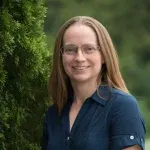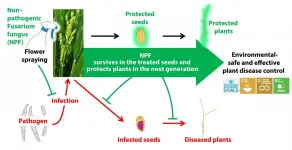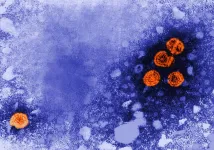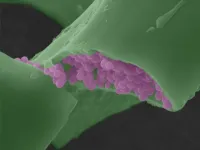NANOGrav researchers - including a number from West Virginia University's (WVU's) Department of Physics and Astronomy and the Center for Gravitational Waves and Cosmology - measure the times of arrival of radio pulses from exotic stars called pulsars with large radio telescopes, including the Green Bank Telescope (GBT) in Pocahontas County, West Virginia. Pulsars are small, dense stars that rapidly rotate, emitting beamed radio waves, much like a lighthouse. The results from this most recent dataset show perturbations in the arrival times from these pulsars that may indicate the effects of gravitational waves, as reported recently in The Astrophysical Journal Letters. The most likely source of these gravitational waves is the combined signal from all the supermassive black hole pairs at the cores of merged, distant galaxies.
NANOGrav has been able to rule out some effects other than gravitational waves, such as interference from the matter in our own solar system or certain errors in the data collection. These newest findings set up direct detection of gravitational waves as the possible next major step for NANOGrav and other members of the International Pulsar Timing Array (IPTA), a collaboration of researchers using the world's largest radio telescopes.
Dustin Madison, a postdoctoral researcher at WVU, comments "We can't yet say with confidence that what we're seeing is gravitational waves, but if it is, the "signal" makes a lot of sense given what we think we know about supermassive black holes. This was always how this was going to play out...enticing hints of a signal before we would be able to definitively claim a detection. We're on the right track to make that definitive assessment in just a couple of years." Looking to the future, he thinks researchers will then be able to characterize the signal and learn more from it for years and years to come.
Gravitational waves are ripples in space-time caused by the movements of incredibly massive objects, such as black holes orbiting each other or neutron stars colliding. Astronomers cannot observe these waves with a telescope like they do stars and galaxies. Instead, they measure the effects passing gravitational waves have, namely tiny changes to the precise position of objects - including the position of the Earth itself. Gravitational waves were first detected in 2015 by NSF's Laser Interferometer Gravitational-Wave Observatory (LIGO) by a team including other researchers at WVU. Like light from distant objects, gravitational waves are a cosmic messenger signal - one that holds great potential for understanding "dark" objects, like black holes.
NANOGrav chose to study the signals from pulsars because they serve as detectable, dependable Galactic clocks. These small, dense stars spin rapidly, sending pulses of radio waves at precise intervals toward Earth. Pulsars are in fact commonly referred to as the universe's timekeepers, and this unique trait has made them useful for astronomical study.
But gravitational waves can interrupt this observed regularity, as the ripples cause space-time to undergo tiny amounts of stretching and shrinking. Those ripples result in extremely small deviations in the expected times for pulsar signals arriving on Earth. Such deviations indicate that the position of the Earth has shifted slightly. By studying the timing of the regular signals from many pulsars scattered over the sky at the same time, known as a "pulsar timing array," NANOGrav works to detect minute changes in the Earth's position due to gravitational waves stretching and shrinking space-time.
WVU Professor and NANOGrav member Sarah Burke-Spolaor explains "This signal is incredibly enticing. It could be that our orchestra is tuning up, hinting that we're about to hear the grand symphony of waves from supermassive black holes that we expect pervades the Universe," Burke-Spolaor reflects. She adds, "If this signal is indeed gravitational waves, future study will offer unique insights into how the biggest black holes and galaxies in our universe form and evolve".
"NANOGrav has been building to the first detection of low frequency gravitational waves for over a decade and today's announcement shows that they are on track to achieving this goal," said Pedro Marronetti, NSF Program Director for gravitational physics. "The insights that we will gain on cosmology and galaxy formation are truly unparalleled."
NANOGrav is a collaboration of U.S. and Canadian astrophysicists and a National Science Foundation Physics Frontiers Center (PFC). Maura McLaughlin, WVU Professor and Co-Director of the NANOGrav PFC, added "We are so grateful for the support of the NANOGrav PFC, that's allowed us to dramatically increase both the number of pulsars being timed and the number of participants working on NANOGrav research over the past six years". WVU has played a significant role in the PFC; 12 of the 63 authors on this paper are WVU faculty, postdocs, and students. And low-frequency gravitational wave detection is one of the main aims of the Center for Gravitational Waves and Cosmology, formed in 2015 along with the award of the PFC. As, Duncan Lorimer, WVU Professor and Eberly College Associate Dean for Research, notes "The long-term institutional support provided by the College and University has played a critical role in NANOGrav's success since its inception in 2007".
NANOGrav created their pulsar timing array by studying 47 of the most stably rotating "millisecond pulsars" with both the GBT and the Arecibo Observatory in Puerto Rico as reported in the January 2021 Astrophysical Journal Supplements. Not all pulsars can be used to detect the signals that NANOGrav seeks - only the most stably rotating and longest-studied pulsars will do. These pulsars spin hundreds of times a second, with incredible stability, which is necessary to obtain the precision required to detect and study gravitational waves.
Of the 47 pulsars studied, 45 had sufficiently long datasets of at least three years to use for the analysis. Researchers studying the data uncovered a spectral signature, a low-frequency noise feature, that is the same across multiple pulsars. The timing changes NANOGrav studies are so small that the evidence is not apparent when studying any individual pulsar, but in aggregate, they add up to a significant signature.
Potential Next Steps
To confirm direct detection of a signature from gravitational waves, NANOGrav's researchers will have to find a distinctive pattern in the signals between individual pulsars. At this point, the sensitivity of the experiment is not currently good enough for such a pattern to be distinguishable. Boosting the signal requires NANOGrav to expand its dataset to include more pulsars studied for even longer lengths of time, which will increase the array's sensitivity. In addition, by pooling NANOGrav's data together with those from other pulsar timing array experiments, a joint effort by the IPTA may reveal such a pattern. Students and faculty at WVU are important contributors to this effort, and in fact 24 WVU students have traveled to IPTA partner countries to undertake research abroad as part of NSF-funded programs led by WVU.
At the same time, NANOGrav is developing techniques to ensure the detected signal could not be from another source. They are producing computer simulations that help test whether the detected noise could be caused by effects other than gravitational waves, in order to avoid a false detection.
While the next several years hold a great deal of scientific promise, they are not without challenges. With the recent collapse of the Arecibo Observatory's 305-meter telescope, NANOGrav will be seeking alternate sources of data and working even more closely with their international colleagues. Although significant delays in detection are not expected, due to years of very sensitive Arecibo data already contributing to their datasets, the loss of Arecibo is a terrible blow to science in general. For NANOGrav, it may impact the ability to characterize the background and detect other types of gravitational-wave sources in the future in the absence of another instrument. The loss of the telescope also directly impacts the graduate studies of several WVU PhD students. NANOGrav members are deeply saddened by the collapse and its impact on the staff and the island of Puerto Rico.
INFORMATION:
Publications referenced in this article
Gravitational Wave Search:
https://iopscience.iop.org/article/10.3847/2041-8213/abd401
Narrowband Dataset:
https://iopscience.iop.org/article/10.3847/1538-4365/abc6a0
Wideband Dataset:
https://iopscience.iop.org/article/10.3847/1538-4365/abc6a1
For more information about NANOGrav, please visit the website at http://nanograv.org.
NANOGrav research at WVU is supported through NSF PFC award #1430284 and NSF OIA award #1458952. The Arecibo Observatory is a facility of the National Science Foundation operated under cooperative agreement (#AST-1744119) by the University of Central Florida (UCF) in alliance with Universidad Ana G. Méndez (UAGM) and Yang Enterprises (YEI), Inc. The Green Bank Observatory is a facility of the National Science Foundation operated under cooperative agreement by Associated Universities, Inc.




